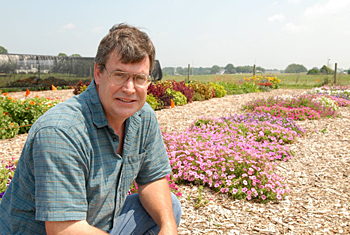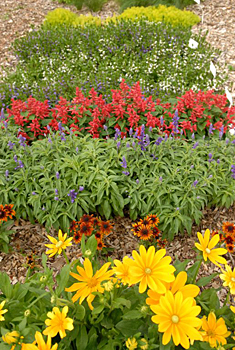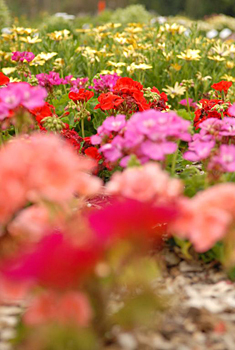Wave Blue petunias were all the rage in 2003 and continue to be best-sellers in garden stores. The Evolution salvia was a hit in 2006. What will be the hot flower in 2008?
Visit the UD Botanic Gardens (UDBG) new color trials garden and you'll get a sneak peek at next year's award-winning blooms. The 1/3-acre garden, a riotous jumble of colors and textures, was installed this summer on what had been fallow land, just south of the Fischer Greenhouse.
The garden serves several purposes, John Frett, UDBG director, said. First, it educates local gardeners about All-America Selections winners. Currently in bloom are 2008 winners Skippy XL Plum-Gold violas and Asti White, a daisy with a blue center. These plants will be available nationwide beginning next spring.
All-America Selections is a nonprofit organization that evaluates new seed-grown vegetables and flowers via impartial trials throughout North America. Established in 1932, All-America Selections is the oldest testing organization of its kind.
Frett said the UD color trials garden also serves as a trial garden for commercial seed companies that are interested in unbiased feedback about new varieties. Visitors to the garden may find these varieties in their local garden store in a few years--or perhaps not--depending on how the plants do at the UDBG, as well as at other test sites nationwide.
And last, but certainly not least, the trials garden serve as a hands-on classroom for UD undergraduates and graduates, ranging from first-year landscape design majors to fellows in the Longwood Graduate Program.

“The trials garden is all about real-world gardening conditions and real-world consumer preferences,” Lyons said.
In other words, don't expect to find rare orchids and unusual cultivars here. Through the years, the All-America winners have been cultivars of tried-and-true favorites: geraniums, pansies, petunias, impatiens, violas, zinnias and salvias.
These aren't the flowers that horticultural aficionados drool over, but that's not the point, Lyons said. “Most of the winning varieties offer bright, vibrant blooms, and that's what the majority of home gardeners want in their landscape.”
Undergraduate landscape design majors tended to the color trials garden this summer, but they didn't offer the plants much TLC. It's not that they were lazy; they were merely following instructions.
“We give the plants minimal care because the garden is designed to simulate real-world conditions,” Frett said.
So the garden's 230 different varieties were mulched and fertilized when they were planted, but not after that. Watering only occurred if there had been several consecutive days without rain.“The home gardener can't devote time to the garden the way that staffers at Longwood Gardens or the UDBG can,” Lyons said. “We need to provide the seed companies with performance data that predicts how well these plants will do in the average home garden in this area.”
UDBG staff member Claudia Bradley has been responsible for collecting that data on a weekly basis. Data analysis will be occurring throughout September. To see the results, check [http://ag.udel.edu/other_websites/udbg/index.html] after Nov. 15.
Article by Margo McDonough
Photos by Danielle Quigley



